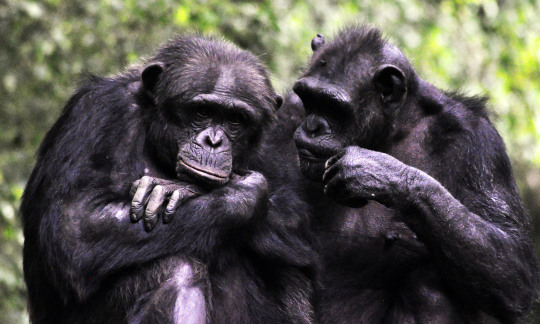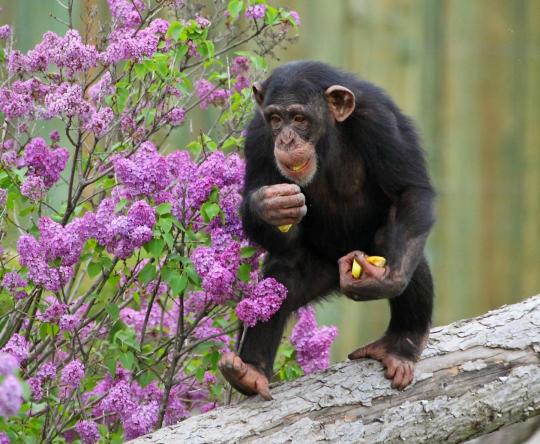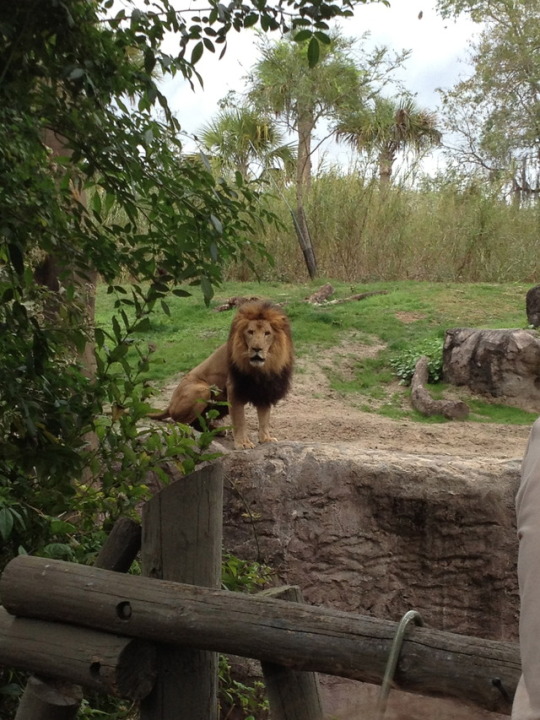Photo





13 Animals Grumpier Than Grumpy Cat
#big cats#tiger#jaguar#San Diego#California#sdzsafaripark#lion#African lion#mountain lion#Lyon#anthrozoology
5K notes
·
View notes
Text
Learning is fun, I too throw unloved vegetables back at researchers.
Animals know when they are being treated unfairly (and they don't like it)

Humans beings appear to be hardwired to have a sense of fairness. This is puzzling from an evolutionary perspective, which you would have thought would mean we were predisposed to seek advantage for ourselves and our families wherever possible. But in fact a sense of fairness is important for humans to be able to help each other. Human cooperation is based on reciprocal altruism – we help people because they’ve either helped us in the past or they may help us in the future.
This form of cooperation is only possible when individuals are able to keep track of other individuals’ efforts and payoffs – and a sense of fairness helps with this. But what about non-human animals? Is sense of fairness unique in differentiating humans from other animals or has it evolved in other non-human animals too?
There’s a way of testing for this in animals using an “inequity aversion task”.
One test subject receives a reward for completing a task, while an experimental partner gets a “booby prize” – something they don’t particularly like. You’d imagine that individual animals that have a strong sense of fair play would either stop taking part in the experiment or refuse the treat.
One of the first species that was tested for inequity aversion were brown capuchin monkeys. In a task where the monkeys had to exchange a token for a treat, one individual was given a piece of cucumber in exchange for a token, whereas a model individual – another monkey not the focus of the experiment – in an adjacent cage got a grape for the same action. Capuchin monkeys prefer grapes to cucumbers – and the individual receiving the cucumber soon started to “protest” by throwing the unloved vegetable back at the experimenter
Read more via Phys
#animals#animal fun#learning#zoology#fairness#equity#animal cognition#animal behavior#comparative psychology#anthrozoology#more alike than you think#monkeys#vegetables#research#animal research
331 notes
·
View notes
Link
572 notes
·
View notes
Photo



Just some sea creatures off the San Pedro coast.
#san pedro#California#sea#seascape#sea anemone#purple#hermit crab#sea animals#coast#California coast#wildlife#nature#green spaces#waves#low tide#tide pools#beautiful#zoology#marine#marine life#ocean#Pacific Ocean#Pacific Ocean life
0 notes
Photo


A bonobo (Pan paniscus) seen earlier this week at the San Diego Zoo. "The bonobo is only found in one country, the Democratic Republic of the Congo." (Arkive.org)
#zoo#animal#animal standards#aza#accredited#bonobo#san diego#san diego zoo#chimps#great ape#great apes#Arkive#wildscreen#arkive.org#aza zoo#habitat#pro zoo#no zoo#not a monkey#enrichment#animal care#democratic republic of the congo#DRC#anthrozoology#animals are people too
6 notes
·
View notes
Photo





Meet some of our “near and deer” friends.
#SDZ#SDZG#san diego#california#CA#moose#deer#antler#antlers#zoo#AZA#anthrozoology#animal#animals#fangs#fuzzy#zoological garden#san diego zoo#zoology
2K notes
·
View notes
Photo




Great feature of the Philadelphia Zoo: the big cats can wander overhead and have meetings
#zoo#exhibits#oldest zoo in the US#philadelphia#philadelphia zoo#zoology#lion#great cats#cat#lions#lioness#zoo360#new ideas#zoo expansion#anthrozoology#zoo modification#zoos change#animal welfare#animal care#carnivores#big cat crossing#tiger#tunnels#animal#animals overhead#AZA#accredited#accredited zoo#anthro-zoology
73 notes
·
View notes
Text
Oh Frans
The link between language and cognition is a red herring
by Frans de Waal

Scientists working on animal cognition often dwell on their desire to talk to the animals. Oddly enough, this particular desire must have passed me by, because I have never felt it. I am not waiting to hear what my animals have to say about themselves, taking the rather Wittgensteinian position that their message might not be all that enlightening. Even with respect to my fellow humans, I am dubious that language tells us what is going on in their heads. I am surrounded by colleagues who study members of our species by presenting them with questionnaires. They trust the answers they receive and have ways, they assure me, of checking their veracity. But who says that what people say about themselves reveals actual emotions and motivations?
This might be true for simple attitudes free from moralisations (‘What is your favourite music?’), but it seems almost pointless to ask people about their love life, eating habits, or treatment of others (‘Are you pleasant to work with?’). It is far too easy to invent post-hoc reasons for one’s behaviour, to be silent about one’s sexual habits, to downplay excessive eating or drinking, or to present oneself as more admirable than one really is.
Read more via Aeon
#Frans#frans de waal#animals#apes#animal#animal life#zoology#primatology#animal care#animal study#cognition#animal cognition#animal behaviour#behavior#emotions#motivations#animal emotion#animal speak#animal thinking#attitudes#research#animal research#comparative psychology
270 notes
·
View notes
Photo

“At about nine to 10 weeks, infant gorillas begin to crawl on their own and soon walk on all four limbs. A white patch of hair appears on their rumps at about the same time they begin to walk. The white patch helps the mother keep track of the infant and assists other group members in identifying the gorilla as an infant. The rump patch begins to disappear at about age 3, the same age that weaning usually begins.“- (animalcorner.co.uk)
Gorilla- Enzi, Busch Gardens Tampa, 2016
#gorilla#gorilla fact#great ape#not a monkey#ape#Enzi#western lowland gorilla#busch gardens#busch gardens tampa#myombe#myombe reserve#gorillas#baby gorilla#baby Enzi#male gorilla#baby#baby animals#enrichment#in human care#habitat#BGT#BG#theme park#animal exhibit#exhibit#animal habitat#naturalistic habitat#zoo#zoology#Lyon
0 notes
Text
LET THE LEARNING BEGIN
Flat-footed competitors have fighting advantage
Source: National Science Foundation

A heel-down posture – a feature that separates great apes, including humans, from other primates – confers advantages in fighting, according to a new study published today in the journal Biology Open.
Standing with heels planted allows more swinging force when fighting, says biologist David Carrier of the University of Utah, lead author of the study, which was funded by the National Science Foundation’s (NSF) Division of Integrative Organismal Systems. In contrast, many other species of mammals, including most primates, stand, walk and run with their heels elevated, and on the balls of their feet or toes, a posture important for quickness.
“This story is one more piece in a broader picture, a suite of distinguishing characteristics that are consistent with the idea that we’re specialized at some level for aggressive behavior,” Carrier says.
Program director Emily Carrington of NSF’s Division of Organismal Systems says the findings provide insight into how animals respond to danger.
“Certain species tend to be good at fighting or fleeing, but not both,” Carrington says. “This study provides insight into the basis for this trade-off. Animals that use their heels to plant their feet firmly to the ground, like bears, badgers and great apes, are able to deliver stronger blows to their opponents.”
The physiological traits that confer advantages in fighting are different from those required for other tasks, such as running.
“If aggression was important in our past, we should see evidence of it in our anatomy,” Carrier says.
Read more via EurekAlert
#apes#great apes#chimps#animal#gorilla#biology#evolution#history#animals#zoology#physiology#aggressive#learning#aggression#university
21 notes
·
View notes
Photo

Welcome. Here’s a beautiful male lion at Busch Gardens Tampa Bay cerca 2012-2013.
Read the blog description to find out what you’ve gotten yourself into.
#zoo#aquarium#AZA#lion#roar#AZA zoo#accredited#animals#animal rights#animal welfare#animal standards#carnivore#carnivore TAG#lion studbook#no zoo#pro zoo#anti zoo#anthrozoology#new#opening#lyon#male lion#leon#fence#Busch Gardens#busch gardens tampa#tampa#Florida#FL#tampa FL
0 notes